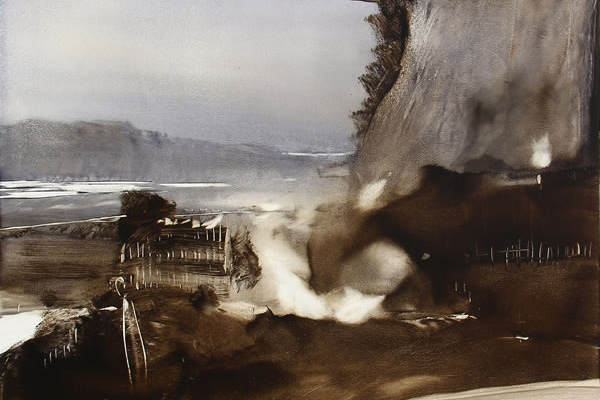Gary Currin
Hints for the Incomplete Traveller
Exhibited until 27 August 2014
Gary Currin was in Wanganui in 1952 and has been exhibiting his work since 1976. His paintings and exhibitions have gained national momentum, placing Currin within the sphere of significant New Zealand artists alongside people like McCahon, Hotere, and Woollaston. Currin was a finalist in the Wallace Visa Gold Award in 1999, and a finalist in the James Wallace Awards 10 times since 1995. He also won the “people's choice” vote in 2004. In 2008 Currin won the grand prize in the Team McMillan “Where Brush Meets Bonnet” BMW Art Award and, in 2011, a merit in the NZ Painting and Printmaking Award. His work is included in various significant collections and, excitingly, he is currently being exhibited here in Dunedin at the Milford Gallery.
The exhibition title, Hints for the Incomplete Traveller, encapsulates the experience of Garry Currin’s paintings. The works are suggestive rather than explanatory; Currin tells part of the story but leaves viewers time and space to extend and complete the narrative as it suits them. From my perspective, the painting seems to reflect the moments a traveller vaguely remembers.
His work is stretched across the gallery walls, drawing on cinematographic traditions of representation. Currin’s paintings allude to sepia-toned photographs or frames from faded eight-millimetre film and each small panel reveals a self-contained world where individual stories overlap and time and place are fluid. Currin directs the framing and focus of each “shot,” revealing only parts of the wider narrative structure and, in this, it seems that Currin's paintings are not merely allegories conveying meaning through symbolic representation, nor do they seek to imitate reality. Rather they employ a sort of lyrical form of abstraction, where the emotive and expressive qualities of colour, shape and brushwork, capture first the artist's feelings, and subsequently the viewer's.
Landscapes appear to be the subject, yet the dark shades, the atmospheric smudges of light and shadow, present moments of another world that shifts between experience, memory and dream. The oil paint allows for this type of rendering, as the fluidity of the medium parallels the fluid nature of memory, dream and reflection, as it passes through our thoughts as flickering, blurred fragmentary images. It’s very Edvard Munch.
The individual paintings in the exhibition are small, intense works and they radiate within their delicate frames. Currin uses overexposed points of light as visual signposts that draw the eye into and across the surface of the panels. Using a limited palette, he layers tone upon tone, creating a rich depth within the lightness of the framework. More figurative than his earlier bodies of work, Currin has populated the stories with people and places that are almost recognisable. (Almost, as they appear as half-forgotten memories, which have warped and changed over time.)
Accompanying the “storyboards” is a single large work on canvas, which showcases Currin’s skill with his medium. From a raised point of view, the viewer looks down onto a shifting landscape that is touched with light. Dominating the foreground are shadowed plains and a solid sweep of hillside; Currin captures simultaneously the solidity of the landscape, and its mutability.
Behind Currin's paint application lays a history of New Zealand's art. If we are looking for signs of our painterly traditions there are hints of John Gully's somewhat Arcadian landscapes, a certain darkness of the New Zealand psyche implied by Colin McCahon, and even Toss Woollaston's "mountainous scrumblings," come to mind when looking at Currin’s work, but in the end Currin's paintings provide us with a visual negotiation of man's subtle and shifting relationships with the land, with history and with our sense of the spiritual.



